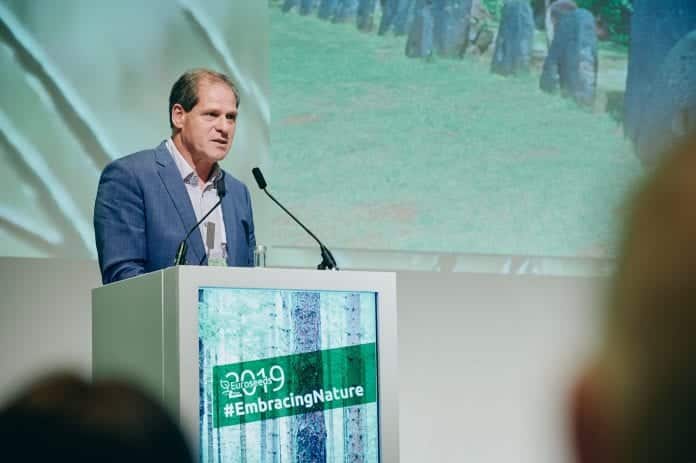The outbreak of food-borne diseases, false labeling and food fraud issues are just some of the various problems that the agriculture industry is facing today. Some say that blockchain can change all of this. This new technology reveals where the food is originated, who planted it, and how fresh it is. In a recent presentation at the Euroseeds Annual Meeting in Stockholm, Louis de Bruin, Blockchain Thought Leader at IBM provided his take on the possibilities and benefits of blockchain for the food chain.
De Bruin explained what blockchain actually is, adding that when people hear about blockchain, most people think about bitcoin, cryptocurrencies and enormous computer centers. But he also underlined that it is much more than that. The principle of blockchain is that you have a common ledger, and together with other partners in the chain, the parties decide what is true and what isn’t. That means that you no longer need somebody in the middle, who is in a position of power to keep track of things, e.g. like a bank. With blockchain, everything is noted from start to finish. Blockchain is a ledger that the involved parties all use to gain consensus about something. And Bitcoin, which came around in 2009, is very similar to this; it is thousands of computers working together and keeping check on each other.
Business Transactions
If a transaction takes place, a transaction is transmitted throughout the network and everybody checks that they have the same copy of the ledger as their neighbor. And even without a central party, parties can still know that everybody is having the right version of the truth. To provide further clarification, De Bruin asked to imagine starting with a typical business network where there are a large number of parties that take part in a transaction. There are sellers, buyers, transporters, banks, insurance companies, etc. It is not unusual to have one hundred or more parties involved for one transaction. And many of these systems are totally decentralized.
But to know more about the transaction, each party has to talk to someone else all the time. Everybody checks something with somebody else, e.g. if a certain invoice has been paid, whether the goods have been transported, whether it has been insured, whether the port authorities have been informed, etc.
In an imaginative business transaction with 100 parties, this would lead to 100×99 interactions, so close to 10,000 interactions. In practice, it would not be that high, but one could easily talk about thousands of interactions for one transaction. Nowadays, this all happens through email, and automatic data interchange, but this can give all sorts of problems, e.g. something breaks down, or fraud, and you often need middlemen to take care of that. This is a major and growing issue. There is a lot of information interchange, and the global market is only growing, so there will be more of such challenges.
With a blockchain tool, the situation changes because of the shared ledger as explained above. Parties will still experience exactly the same business network, but not everybody is exchanging data with each other, but everybody is exchanging data through the blockchain. Going back to the example of hundred parties, there would only be 100 interactions, instead of several thousands. And this means a huge simplification of exchange.
It is the computers that keep each other in check and ensure that all parties have the same consensus about what the truth of the ledger is. And to do that so-called “smart contracts” are needed which are run on the blockchain. But these are also distributed, and there is not one central party which is doing that. A consensus mechanism is still needed, and in the blockchain approach, that is a mathematical system that creates such a mechanism through calculations.
Handling Privacy
De Bruin also mentioned that privacy and confidentiality are a very important topic. Just like on the internet, it is not only yourself that is using the information and your customers, but possibly also your competitors. And you absolutely want to be sure that the data that you share with others is kept confidential. In this context it is evident that cryptography is an essential part of blockchain technology, to keep the data confidential. The owner can then decide when somebody can get access to the data, which may already be on the customers computer, but cannot be read without the right key. With the key, the other party can unlock, and verify that the information is correct.
The beauty of blockchain is that there is an enormous simplification in networks. But this requires standards, and cooperation between parties. Comparing this to bitcoin, there is one major difference, which is in the amount of energy that is consumed. With bitcoin, the consensus mechanism is carried out at large data centers and it is the data centers that consume enormous amounts of electricity. With the type of blockchain described here, this is not necessary. At IBM, and with their customers and partners, they use a different type of consensus mechanism, the so-called ‘hyper ledger fabric’ and there is a special consensus algorithm for that.
Blockchain Examples from the Food Chain
Many people think that blockchain is limited to cryptocurrencies like bitcoin and cerium etc. shared de Bruin. But there are many more real-life uses of blockchain in very different industries, e.g. in crime reduction, trade finance, logistics, container transportation, but also in food safety, which is what is closest to the activities of Euroseeds and its members. The IBM Food Trust approach is probably the most interesting example. This is not a blockchain that is totally evolved, but it is operational, and being used, but also open for new developments.
This approach provides a shared replicated ledger across the food supply chain, with the main aim of creating food trust for all the parties involved. This can be done with the help of producers’ records and retailers’ records which often can be shared across the blockchain.
In the past, if a customer wanted to know where a certain package of food came from, who harvested and packaged the product etc. it would take 2-3 weeks of forensics to find out what exactly happened to that package. It would require research of all the steps between the grower and the supermarket. With blockchain, this whole process has been reduced to a number of seconds.
On the voyage towards Food Trust, his company started with partners like Walmart and Carrefour, which are major forces in the food chain and can drive these sorts of new standards. At the moment they work on projects such as tracing mango in the US, pork in China, poultry in Spain, and especially leafy greens in America.
Buying Blockchain Technology
He also mentioned that at the moment in IBM food Trust there are three operational modules that people could buy “off the shelf” if they wanted to use them. One of them is “Trace and Recall” when it is very important that a party can instantaneously find out where the products are coming from and if necessary, can do a very fast recall, if there is anything wrong with the product. Other modules are the “Data Entry and Access” or the “Certificate Management” modules. In the latter one, people can know which certificate exactly is issued so there can be no fraud. With blockchain parties can check that the certificate is the actual certificate that people were allowed to use and can be used to certify that the product is exactly what it says it is.
These are the first three modules that are being used, and other modules are being developed.
Overhauling Business Process
According to de Bruin, there is no need to overhaul the regular business processes. The business process and systems of record that an organization and its customers already have are not replaced by blockchain. Just like the internet did not erase all the information that was available, it just connected them all together. Blockchain is the way to tie it all together and to have standards by which you share these data and so that you are absolutely sure that the information you get is the right information. And it is instantaneously available.
Another interesting aspect of blockchain it that one can see who is waiting for information, why that person is waiting for that information, and who is not doing the task that they should be doing. It is a very disciplined form of working together. Blockchain takes away time, in the same way that the internet took away distance. It removes a lot of administrative work out of the business processes that organizations are using at this moment.
There are some very pertinent reasons why blockchain is being used. One of them came in the wake of the romaine lettuce E. coli scare in the U.S., where Walmart demanded from its suppliers to use blockchain technology, to better track leafy greens. Another example here in Europe is how Carrefour is joining with Food Trust, together with the supplier of Mousline (a type of potato mash), to find out what type of potato is being used in the actual product, and what happened all along the chain. These are some very concrete examples of what has been happening already, apart from many others.
He added that it is only the start and at the moment only a few hundred of parties are involved. But as a company, IBM is very ambitious and aims to connect all the 570 million growers to the 2.7 billion customers, and all parties in between, in this Food Trust blockchain.
Wise Advice
There are certainly a few lessons that he has learned on the various blockchain projects he participated in. First of all, it is important to understand the ecosystem governance from the start. And with ecosystem, he meant the people who you are going to work with, such as suppliers, customers, and perhaps competitors, and how this blockchain is going to be governed. It is important to know how the rules are being agreed upon, which is not that simple.
Secondly it is important to realize that it is not the technology that is driving the process, but the business issues that you have. The blockchain technology is available, and has been around for quite a while, so it is crucial to focus on the business.
And thirdly, the parties need to be very clear on the value that it brings you as an organization, and other organizations and why should people work together on this.
—Marcel Bruins is editor of our sister publication European Seed.













